In tribute to the late master dyer who concocted a tour de force of 100,000 dyes for the silk yarns in my saree. I am privileged and honoured to be the owner and wearer of this saree, to preserve the hard work from his legacy of masterpieces. A saree that will be close to my heart forever; one that commands respect and adoration for the genius skill of the craftsman. He lives immortally through my saree. My sincerest respects to the artisan for a truly handmade masterpiece he’s given me. An ode to the wearable art.

Thank you , Sreemathy @sthreecreatives , the lady boss and textiles teacher who brilliantly envisioned this saree, materialised, produced and delivered this beauty into my world.
One hundred thousand colours resembling the vividly coloured intricate temple towers of Madurai Meenakshi Amman Temple in my Kanchipuram Pattu Pudavai. The arakku hued (kumgumam) thalaippu of my saree starring the Zari photo work of the majestic Southern Gopuram of the Meenakshi Amman temple or should I say the crown jewel of my saree.
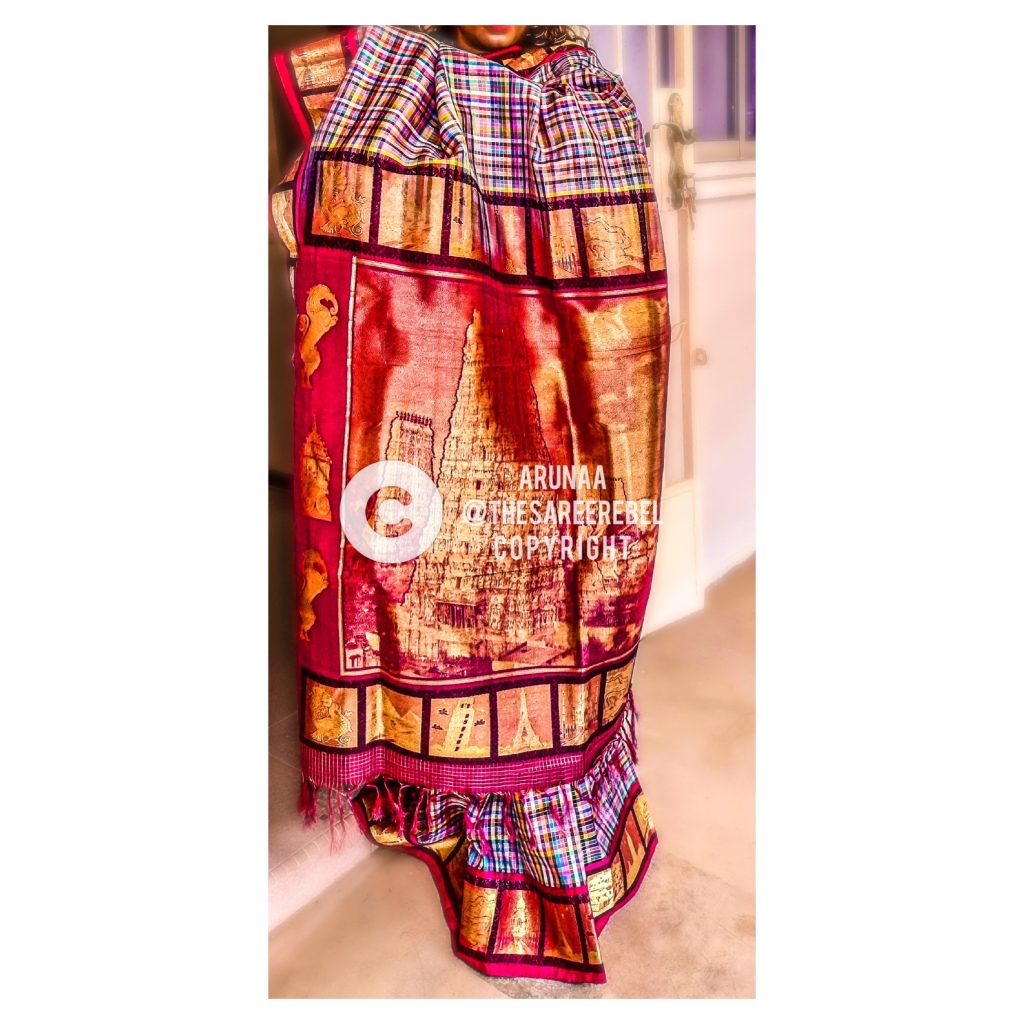
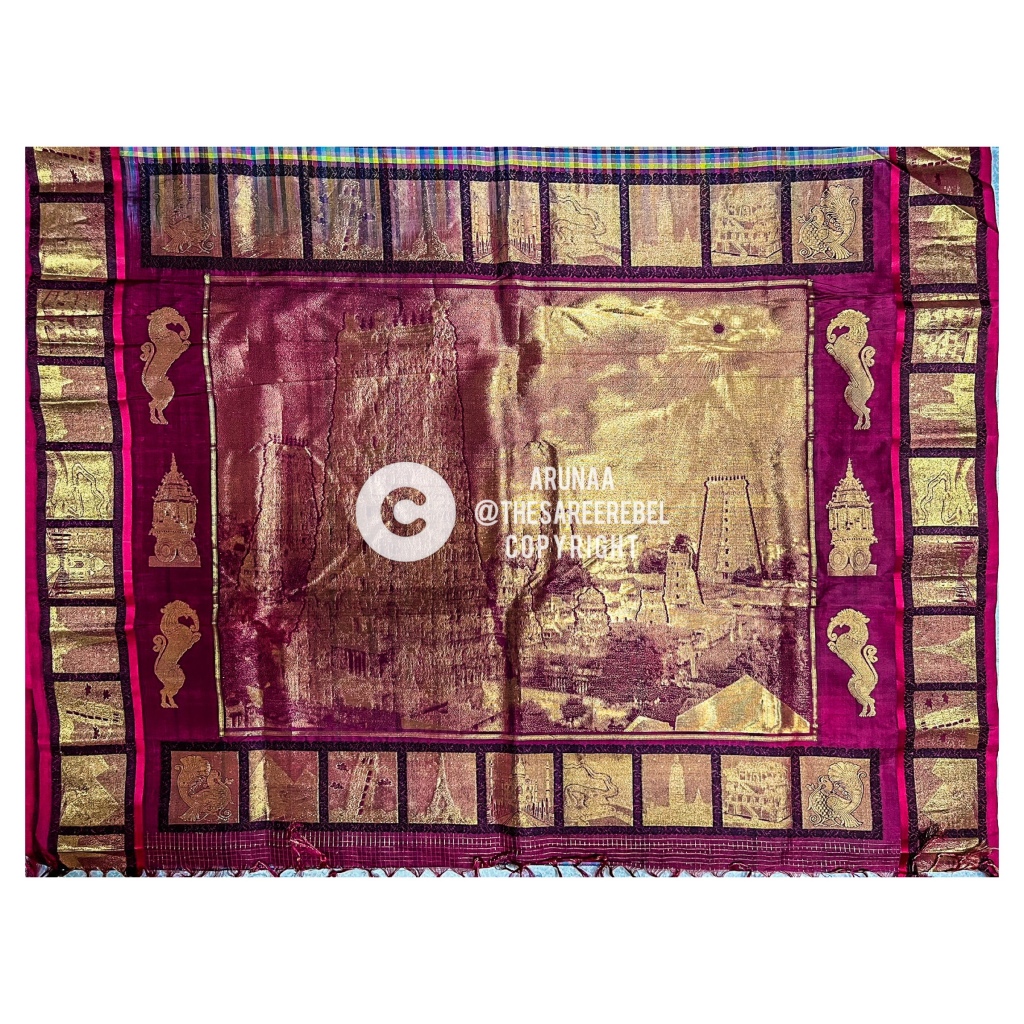

But I am also compelled to drumroll and shine the spotlight on the other features woven into the saree borders. The man made wonders of the world enshrined into the borders. Taj Mahal, The Pyramids of Giza and the Great Sphinx, The Eiffel Tower, The Leaning Tower of Pisa, The Great Wall of China, The Hanging Gardens of Babylon, The Big Ben and to this list the saree weaver and designer cleverly adds the monumental Madurai Meenakshi Temple. Meenakshi Amman temple is hands down a man made marvel. I must include my saree in these man made marvels.

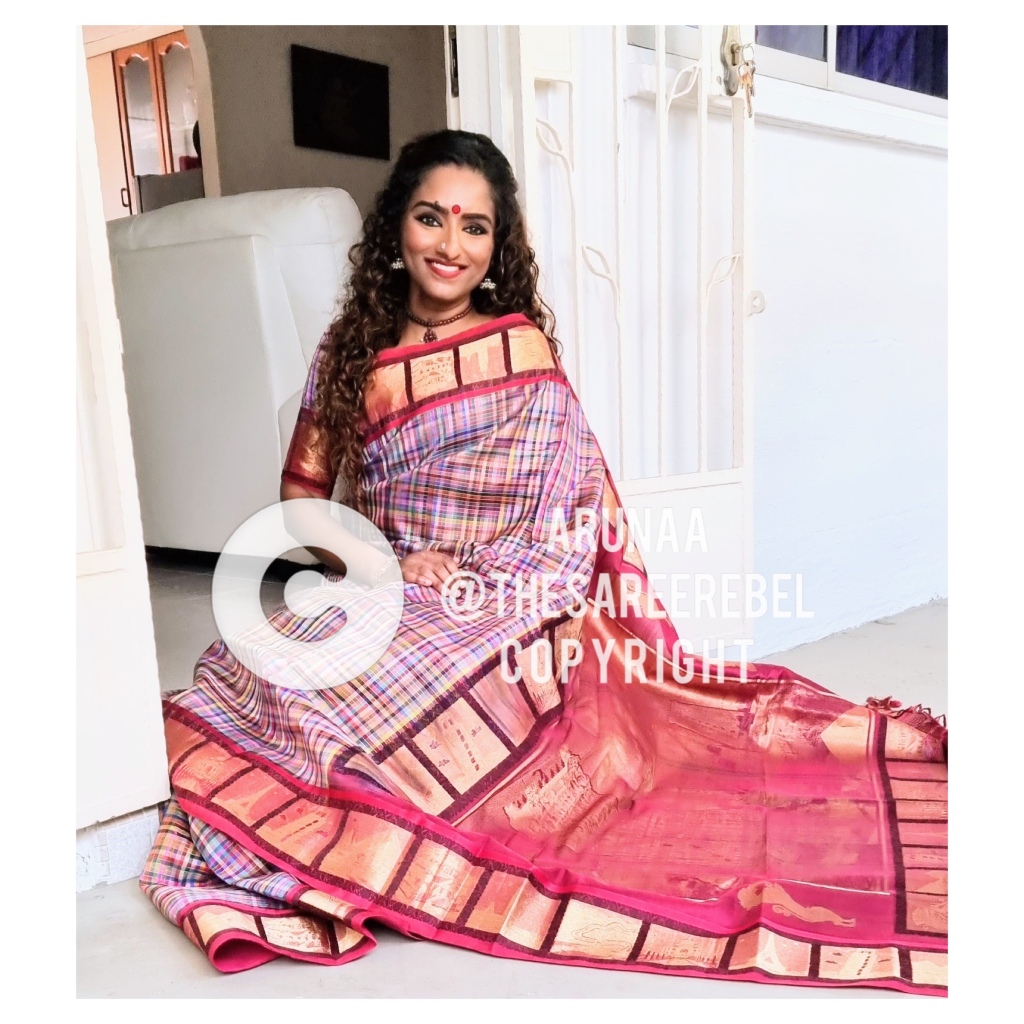

Below I have described the features of the Meenakshi temple i am intrigued by and integrating pictures of my saree into my write up.
All hail the majestic Queen of Madurai, மதுரையை அரசாழும் மீன்விழியாள் மீனாக்ஷி. Meenakshi – Meen Aatchi : The tutelary deity’s totem and royal Insignia of the Pandyan dynasty – the fish personified.

Meenakshi Amman temple is a magnificent monument of unfathomable magnitude of grandiosity, in the legacy of conventional Dravidian architecture. Undoubtedly, the paragon of engineering, architecture, waterworks, settlement, arts and crafts and an incredible genius level of geometric and mathematical precision which has stood the test of time.
The mighty complex is positioned within concentric squares in the core of Kadambavanam that was canonized to Madurai. The surrounding streets are extended from the pivotal temple, framed in squares conferring to the symmetrical layout. More than a sacred, religious, artistic and central spatial distribution of the city, it serves an economical significance.
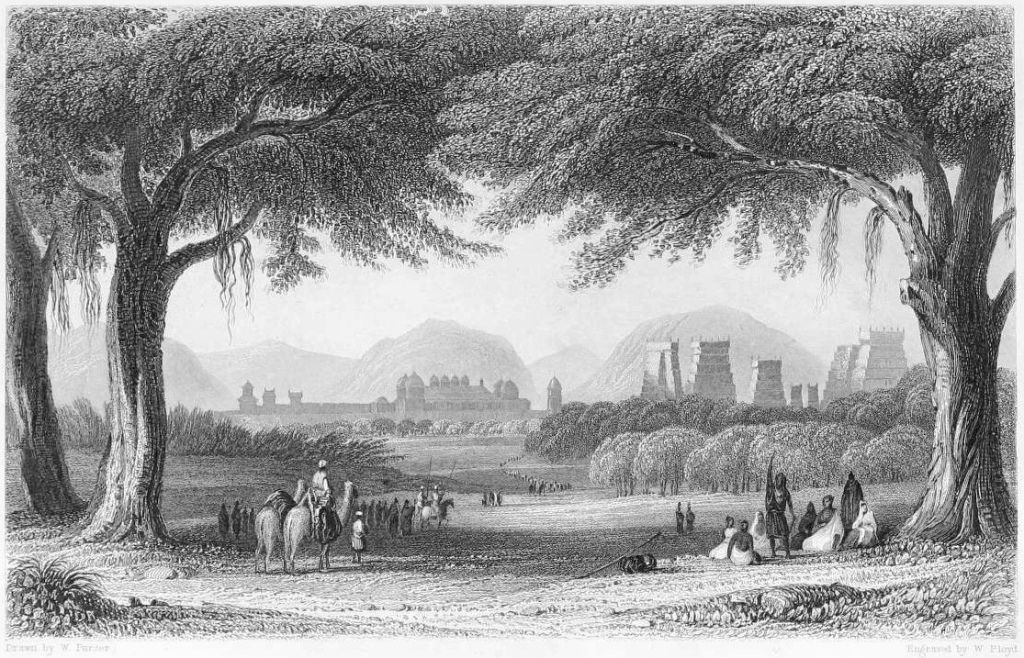


The radial design of the city’s streets accommodates large, extravagant, religious and cultural festival processions with massive vehicles and devotees thronging upon will circumambulate the temple complex. Gives the perspective of the temple being the centrifugal force. Each street is named after the months in the Tamil almanac.



The immediate arresting spectacle one witnesses is the 170 feet tall Southern Gopuram. These are the ornate gateway towers embodying 9 stories of 1500 carved mythical sculptures from the various Tamil Puranas. The most extensively carved panels are found here. This entryway is the tallest and curvilinear among the 4 major (Raja) gopurams (each boasts 9 stories high), encompassing the interior sanctum sanctorums, shrines, water bodies, porches and hallways. These 4 Raja Gopurams have about 4000 intricate carvings telling mythological tales, local legends, scholars, saints, folklore and episodes from the Hindu epics such as Thiruvilayadal – Siva’s Sacred Games written by Paranjothi.
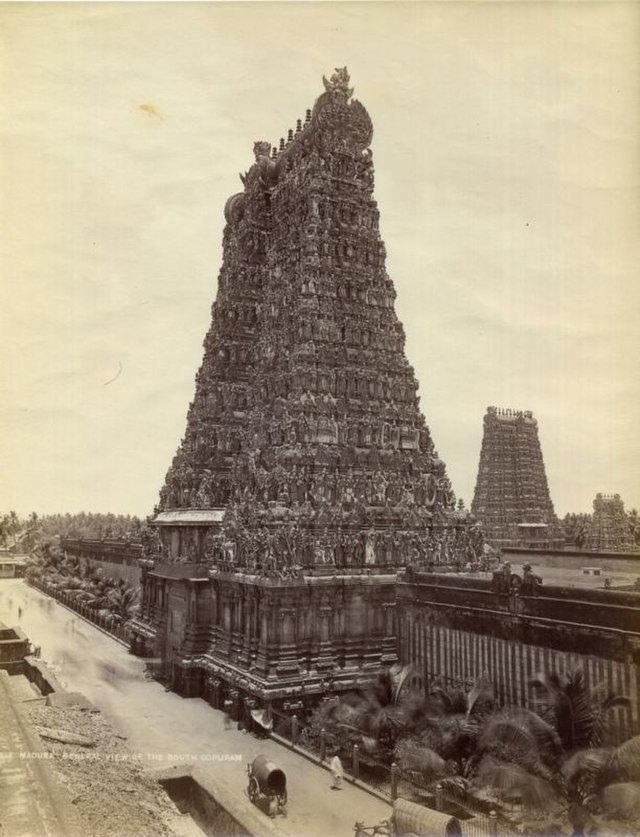





As you step into the fantastical complex, the single granite blocks turned 6825 formidable balusters have about 33000 intricate carved sculptures inspired by the history of the ruling monarchs, the Hindu pantheon of Asuras and Devas and Tamil folklore serve as a visual feast.
The blueprint of this colossal structure revealed optical precisions of an imaginary straight line traversing the Linga statue in the Sundareshwarar sanctum sanctorum when mapped from the East tower to the West tower. Similarly, a connecting axis between the North and South towers shows the equidistance in between both the principal sanctums sanctorums (Meenakshi and Sundareshwarar). Both the sanctum gopurams have their 1-storey towers known as Vimanas are strikingly gilded in gold.


In my personal conundrum of idol worshipping of female goddesses (observing rituals in the fertility cult) often defeated by the stark scientific temper, I found myself drawn to the stories revolving Meenakshi Amman. The belief that she is the queen, warrior, patron deity and mother to all her people made me curious about her creation in the mind’s eye in her believers. I was particularly interested in the matriarchal order the goddess represented.
Meenakshi is the reigning deity of the temple and hence devotees by rule worship her first in her Garbha graha before moving to Sundareshwarar’s sanctum. This is a practice in contrast to the typical Shiva temples where he is worshipped first and then the goddess.
As the legend goes, the Pandya king Malayadwaja and his wife Kanchanamalai meditated upon the sacred fire desiring a son – the heir to the throne. The flames summoned up a female child aged 3-years old and born with 3 breasts. The Tamil epic Silapathikaram ends with the female protagonist severing one breast and immolating the entire Madurai city as a result of the injustice meted out to her dead husband by the then ruling king. Legend has it Meenakshi was borne out of the fire in the following epoch with 3 breasts to be the rightful female Pandyan ruler of the same city.
The king heeded the prophecy in which he was told to name the child as Thattatakkai and to raise her as the ruling Queen of his kingdom. She was then coronated as the Queen Majesty to reign over Madurai. Meenakshi proved to be a skilled and formidable warrior in battles where she led her army to victories. She was so ferocious that even the Lord Indra fled for his life. Meenakshi claimed Indra’s Airavata elephant as her trophy. She laid besieges, sacked kingdoms ruled by unfit men and she never surrendered. Until she met the love of her life, Shiva when she was about to contest him in Mount Kailash.
She fell in love at first sight when she laid her eyes upon Shiva. She allayed her weapon, succumbed to Shiva’s seduction, love arrows exchanged and then according to the prophecy, her third breast vanished. They were united in matrimony. To quench the thirst of his guest at his wedding feast, Shiva created Vaigai River from the Ganges residing in his crown. Vaigai river is the cradle of the Madurai civilisation, source of water, life and trade for its people. And inspired by the Mathuram trees from the river’s banks, the ancient city once known as Kadambavanam was canonized as Madurai.
This celestial marriage is immortalized as sculpted carvings of the pillars in the Kambathadi Mandapam. The bas-relief of the wedding scene revealed the exemplary craftsmanship. Such is the sophistication of the sculptures that have perfectly defined fingernails on the hands, sprightly looking statues, third eye of Shiva with his dreadlocks, Vishnu with his exquisite jewellery and especially the coy expression on Meenakshi’s face.
This important piece of work has captured the culmination of 3 powerful forces of the Hindu Pantheon joining hand in hand under the Kadamba (oak) tree – Vishnu (Vaishnavism) the brother who gives away his bride sister Meenakshi (Sakthism) to marry Sundareshwarar (Saivism).
Standing on one side, Visnu took the hand of the goddess, a hand which is like the blooming [white] kantal flower-and placed it into the holy, red, lotus-flower-like hand of the Great One, [Siva].As mantras were chanted, Visnu poured water [onto their hands] from a pot,while celestials poured down showers of flowers as they watched in reverence - from the chapter of the Sacred Marriage in the Siva’s Sacred Games.

She appeared as the holy Daughter of a Pändya king, learned all the sciences, and assured the royal crown, with responsibility for ruling the kingdom. She conquered the entire world, defeating Nandin and his servant forces in battle. She placed on that Lord Whom all worship a beautiful, fragrant wedding garland and Her crown. She graciously gave Him Her crown, and prospered from the wealth so gained. All this She did, this Woman-king whose lotuslike feet are worthy to be placed on the heads of us all. - Kadavul Vazhthu from the Thiruvilayadal
The statue of Meenakshi in her Garbha Graha – sanctum sanctorum is made in a single block of stone in emerald hues. Whether actual emerald gemstones were used is unknown. Arguably, the most exquisite and magnificent of jewellery in the world was discovered on the deity. Each of her collection is prized and precious treasures of India. Unimaginable magnitude of jewels in her vault. The deity’s coronation day – Pattabishekam – is commemorated yearly during the jubilant Chittirai festival in Madurai to crown the goddess in her urchava murthy form (bronze idol made for processions) as Queen before her devotees. The deity Queen mounted on a massive chariot then makes her Royal Entry into the city in a royal cavalcade.


The deity’s crown is embedded with gemstones such as 920 rubies, 78 diamonds, 11 emeralds, 7 sapphires, 8 topaz stones and 197 sovereign gold which were all donated by Appaji Rayar who was a minister during Thirumalai Nayak’s reign. The crown is named after him as the Rayar Crown.
The power wielding sceptre is handed to the deity by Thirumalai Nayak to ceremonially confer the throne upon Meenakshi has 98 sovereign gold, 761 rubies, 74 Cats Eye, 21 diamonds, 269 emeralds, 44 pearls. The pearls were said to be from the Pandya dynasty’s renowned pearl fisheries.

The urchava deity is decked up from head to toe in extraordinarily magnificent and supreme jewellery, finest of silks and parading majestically with pompous musical accompaniment and royal paraphernalia that makes her a phenomenal sight of art to witness. Following her coronation is her sacred wedding with Sundareshwarar that is elaborately celebrated and reenacted by the temple priests before tens of thousands of pilgrims gathered at the temple during the festival.


The priests in the temple rigorously practice the ritualistic drama of the ‘Palliyarai Procession’ every night where Sundareshwarar in the form of a palm-sized feet sculpture set on a lotus peedam is carried in a palanquin and escorted by the priests to Meenakshi’s resting chambers. Meenakshi is in the form of a small statue awaiting him in a white Madurai sungudi saree, adorned with her mookuthi and Madurai malligai flowers. The priests physically align the feet sculpture on the right side of the goddess’s statue to simulate the imaginary nuptial union of Shiva and Sakthi in respect to the fundaments of procreation.
Matriarchy is therefore an ingrained system in Madurai empowering women to lead, be in charge of their lives and the one to be calling the shots in their families. The law of Meenakshi’s matriarchal nature, to rule and to nurture forges the edict that women hold the supreme powers in kingdom, family, marriage and society. Thus, women are to be revered and respected as a rule of thumb. (Whether this is observed in reality is debatable and most of the time a sorry state of affairs.)
You gave birth to the entire universe surrounded by the seas and assumed the name Goddess Tatätakai. You, Siva, the Incomparable One, took on the name of the beautiful Pandya monarch. Why all this, and why did Kumaravel take the name Ugra Pandya? It was because the three of You shared together Your enjoyment of cool, sweet Tamil. And so, who can possibly comprehend the greatness of Tamil?Bees making music melodious as the yaazh, flowers dripping with honey, worn by ladies in the courtyard enclosed by roofs made of pearl: there women of the Tamil land play and sing as would heavenly goddesses whose eyes do not blink. Gods who saw them wondered: "Are these women human or divine?"All this is the greatness of Madurai where You, Lord Siva, wear the serpent in Your hair. - wrote by Kumaraguruparar on the Tamil women of Madurai.
Tirumalai Nayak the main man and orchestrator in developing the temple complex in 17th century and records the episode in writing through Kumaraguruparar, a poet who composes the famous Meenakshi Pillaitamil poem which is an important aspect of Tamil literature dedicated specially to Meenakshi.
Mutthamizh (Iyal, Isai, Nadagam) Literature, art and crafts, music, theatre and dance flourish in Meenakshi’s name. A line from the Pillaitamil: ‘You were born with three breasts in Madurai where all three parts of Tamil flourish’.
Syama Sastri, the eldest music composer of the Trinity of Carnatic music wrote 9 moving songs with structured rhythm and melody, calling upon Meenakshi known as the Navaratnamalika (9 gems). Minalocana, Minanetri, Meenakshamma and Meenakshi were the endearing names he called her in his 9 emotional compositions. ‘
Music and dance are revered as critical intrinsic features of the temple architecture and worship. And I am here to speak about just that.
The Ayiramkal Mandapam (Thousand Pillared Hall) built by Ariyanatha Mudaliyar in 1569 (prime minister and general of the first Nayakar of Madurai – Viswanatha Nayaka) attests to the prominence of music and dance in the invocation of divinity. Although named 1000 pillared, the chamber is constructed with 985 sculpted granite colonnades. In the space for the remaining 15 pillars, the statue of Natarajar is standing tall and mighty.
The statue of its builder mounted on a horse was erected as the entrance of the hall in remembrance of the genius who amalgamated acoustic law, mathematical precision, visual aesthetics, art and architecture. The science behind mass of the surfaces, material, distances between the pillar surfaces, the glazing of surfaces, hence the impact of the sound waves during production and transmission were cleverly brought into play. Reflection in the form of echo, types of echoes and series of echoes are not favourable for acoustics. A well-thought-out construction conformed to the law of acoustics was materialized.
The 985 granite pillars are aligned in rows enabling an optical illusion in which the viewer standing at any vantage point will perceive the rows to be in a straight line and count 16 varying pillars within sight. No symmetry, no parallel walls to prevent echoes. This anomaly allows a person seated down to be able to visually see an object in the middle between 2 rows without an obstruction.
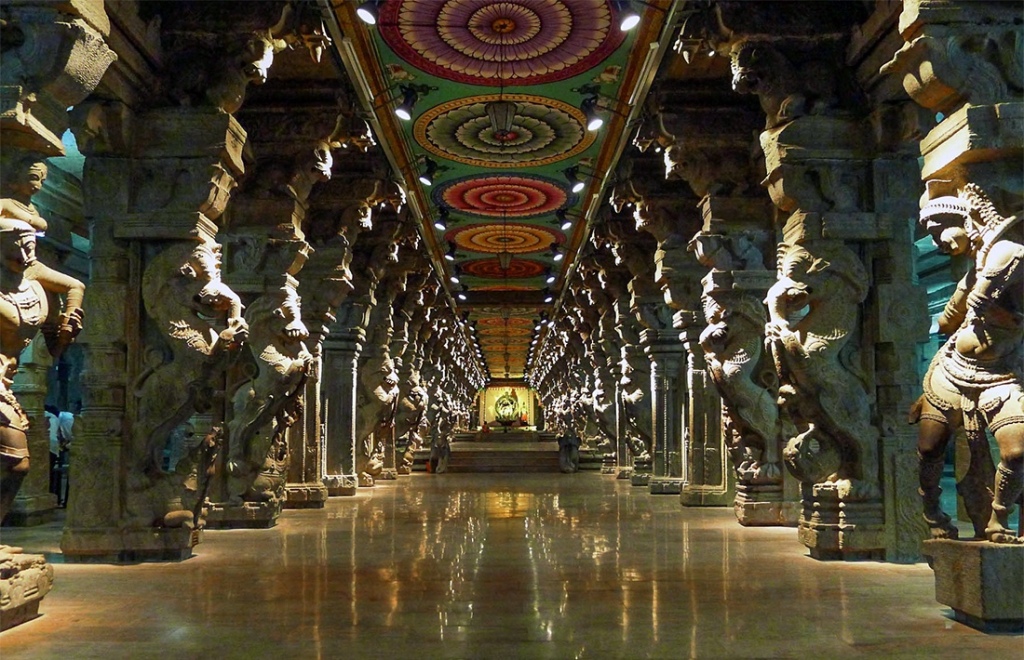
Flanking the start and the end of the rows of pillars are 5 large musical pillars with 22 smaller circular blocks each that produce illusional musical tones of instruments when tapped with a thumb – psychoacoustics.
The pillars are chiselled to have sharp, chamfered and beveled edges instead of rounded ones. Together with the sculpted statues which are convexed (useful in sound diffusion) are curved outwards forming thicker centres diffuse sound effectively. As a result, the surrounding sounds from nature and the space become white noise. The sound diffusion produces a peaceful atmosphere. The statues are mythological beings, the main character is the Yaazhi. In my saree too!



The locals believe one needs a thousand eyes to behold the beauty of the thousand pillars.

Regardless of the nature of the musical instrument played within these spaces; percussion, wind, strings and/ or brass produce a balanced and lush music. The sounds are always within the range of 80 decibels. The echo-resistant Ayiramkal Mandapam is indeed an acoustics marvel. Imagining the masterpiece vocals by Yesudas accompanied by Veenai, Violin, Mridangam & Pulaanguzhal invoking the senses of its Rasika. Mysticism altogether.
The statues are breathtakingly beautiful as their exquisite carvings personify the mathematical principle of Fibonacci spiral. This stems from the golden ratio 1:1.618 ( usually the design basis in Indian architecture )to create visually appealing proportion, size and positions. In other words, these are the basis to shilpa shastra combined with Vasthu Shastra cleverly deployed by the main man Thirumalai Nayak in 16th Century.
The god of dance, Natarajar beholds his spectacular cosmic (Sandhya thandavam) dance pose. However, out of tradition, in the Madurai version, due to the request of his devotee Rajakulasekara Pandya, he stands on his left foot and lifts his right foot instead. This scene is depicted in the Thiruvilaiyadal Puranam, famously known as the Kaal Maari Adiya Padalam.
The majestic dance god’s statue is erected in the Vellichabai of the Silver Temple – Velli Ambalam or the silver Sabai (one of the 5 natarajar’s Sabai) and worshipped as Vellaiambala Natarajar.

A Carnatic classical hymn Kaal Maari Adiya describes the depiction in its verse:
“Padam varundum enru Pandiyan vendida, Vedam Maalum Kaana Vimala Malarppadam nee, Dayavudan Thooki Nirtanamadida, Maadhava muni paatanjali puli pasar kooda”

Here I conclude my musings of my saree and the tales of Meenakshi.



References:
- Edward Fosmire, “The Meenakshi Temple at Madurai,” in Smarthistory, April 3, 2018, https://smarthistory.org/meenakshi-madurai/.
- https://tamilandvedas.com/2013/09/29/the-wonder-that-is-madurai-meenakshi-temple/
- http://EzineArticles.com/9636426
- https://maduraimeenakshi.hrce.tn.gov.in//hrcehome/index_temple.php?tid=31962
- https://lexiconworld.in/2020/09/28/marvels-of-temple-engineering-meenakshi-temple/
- https://www.orientalarchitecture.com/sid/166/india/madurai/sri-meenakshi-temple
- https://www.google.com.sg/url?sa=t&rct=j&q=&esrc=s&source=web&cd=&ved=2ahUKEwjyv8jh4Yb9AhWBm9gFHQsRBU0QFnoECA0QAQ&url=https://www.khanacademy.org/humanities/art-asia/south-asia/x97ec695a:1500-1850-deccan-south/a/the-meenakshi-temple-at-madurai&usg=AOvVaw2G6aYqUYKH6E142C-Kmx_B
- William P. Harman, The Sacred Marriage of a Hindu Goddess (Delhi: Motilal Banarsidass, 1992).
- John Murray, A Handbook for Travellers in India, Burma, and Ceylon(London: J. Murray, 1911)
